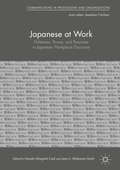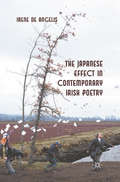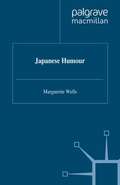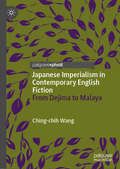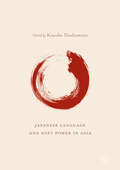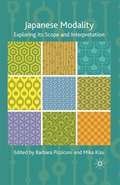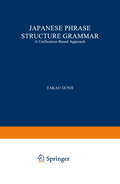- Table View
- List View
Janeites: Austen's Disciples and Devotees
by Deidre LynchOver the last decade, as Jane Austen has moved center-stage in our culture, onto best-seller lists and into movie houses, another figure has slipped into the spotlight alongside her. This is the "Janeite," the zealous reader and fan whose devotion to the novels has been frequently invoked and often derided by the critical establishment. Jane Austen has long been considered part of a great literary tradition, even legitimizing the academic study of novels. However, the Janeite phenomenon has not until now aroused the curiosity of scholars interested in the politics of culture. Rather than lament the fact that Austen today shares the headlines with her readers, the contributors to this collection inquire into why this is the case, ask what Janeites do, and explore the myriad appropriations of Austen--adaptations, reviews, rewritings, and appreciations--that have been produced since her lifetime. The articles move from the nineteenth-century lending library to the modern cineplex and discuss how novelists as diverse as Cooper, Woolf, James, and Kipling have claimed or repudiated their Austenian inheritance. As case studies in reception history, they pose new questions of long-loved novels--as well as new questions about Austen's relation to Englishness, about the boundaries between elite and popular cultures and amateur and professional readerships, and about the cultural work performed by the realist novel and the marriage plot. The contributors are Barbara M. Benedict, Mary A. Favret, Susan Fraiman, William Galperin, Claudia L. Johnson, Deidre Lynch, Mary Ann O'Farrell, Roger Sales, Katie Trumpener, and Clara Tuite.
The January–May Marriage in Nineteenth-Century British Literature
by E. GodfreyBy considering the disruptive potential of age disparate marriages in nineteenth-century British literature, Godfrey offers provocative new readings of canonical texts including Don Juan, Jane Eyre, and Bleak House.
Japan and Japonisme in Late Nineteenth Century Literature (Asia, Europe, and Global Connections)
by Naomi Charlotte FukuzawaThis book examines the transnational phenomenon of Japonisme in the exoticist and “autoexoticist” literature of the late nineteenth century.Focusing on the way in which reciprocal processes of transcultural acquisition – by Japan and from Japan – were portrayed in the medium of literature, the book illustrates how literary Japonisme and the wider processes whereby Japan, with its alien exotic culture and unique refined aestheticism, was absorbing Western civilization in its own way in the late nineteenth century at the same time as the phenomenon of Japonisme was occurring in Western fine arts, which were inspired by traditional Japanese artistic practices. Specifically, the book focuses on the literary works of Lafcadio Hearn and Pierre Loti, who travelled from France and America, respectively, to Japan, and Mori Ōgai and Natsume Sōseki, who in turn went, respectively, to Germany and England from Japan.Exploring the eclectic hybridity of Japan’s modernization during the late nineteenth century, this book will appeal to students and scholars of Japanese Studies, Postcolonial Studies and Comparative Literature.
Japan and Japonisme in Late Nineteenth Century Literature (Asia, Europe, and Global Connections)
by Naomi Charlotte FukuzawaThis book examines the transnational phenomenon of Japonisme in the exoticist and “autoexoticist” literature of the late nineteenth century.Focusing on the way in which reciprocal processes of transcultural acquisition – by Japan and from Japan – were portrayed in the medium of literature, the book illustrates how literary Japonisme and the wider processes whereby Japan, with its alien exotic culture and unique refined aestheticism, was absorbing Western civilization in its own way in the late nineteenth century at the same time as the phenomenon of Japonisme was occurring in Western fine arts, which were inspired by traditional Japanese artistic practices. Specifically, the book focuses on the literary works of Lafcadio Hearn and Pierre Loti, who travelled from France and America, respectively, to Japan, and Mori Ōgai and Natsume Sōseki, who in turn went, respectively, to Germany and England from Japan.Exploring the eclectic hybridity of Japan’s modernization during the late nineteenth century, this book will appeal to students and scholars of Japanese Studies, Postcolonial Studies and Comparative Literature.
Japan and the Cosmopolitan Gothic: Specters of Modernity
by M. BlouinJapan is imagined routinely in American discourse as a supernatural entity. Gothic tales from these two cultures have been exchanged, consumed, and adapted. Here, Blouin examines a prevalent tendency within the United States-Japan cultural relationship to project anxiety outward only to find shadowy outlines of the self abroad.
Japan on the Jesuit Stage: Two 17th-Century Latin Plays with Translation and Commentary (Bloomsbury Neo-Latin Series: Early Modern Texts and Anthologies)
by Akihiko WatanabeThe Jesuits were a major source of European information on Japan from the late 16th to early 17th century. Not only were they active missionaries but they also produced linguistic, religious and cultural tracts, regional chronicles, as well as hundreds of Latin plays written in imitation of classical Greco-Roman theatre but set in Japan. An intriguing yet underexplored segment of Jesuit school theatre is that which stages non-classical, non-Western subjects such as Japan, and this volume is the first to present Latin texts of two of these plays alongside full English translations, commentaries and an extensive introduction. The plays in question - Martyrs of Japan and Victor the Japanese - were performed in Koblenz and Munich, in 1625 and 1665 respectively, and are collated from original 17th-century manuscripts for this edition. They were based on specific events which took place in Japan in 1597 and 1613, and their main characters are historically attested Japanese Catholic converts and their pagan peers. The juxtaposition of the Latin texts and original English translations makes the plays newly accessible to a wide readership, shedding light on the ways in which Western classical humanism rooted in ancient Mediterranean theatre became intertwined with momentous historical developments across the globe to produce these unique spectacles. The introduction and commentary examine the historical, cultural and literary contexts and provide guidance on interpretative and stylistic issues, allowing for a full appreciation of the plays in which pagan classical, Christian, early modern European and Japanese elements come together.
Japan on the Jesuit Stage: Two 17th-Century Latin Plays with Translation and Commentary (Bloomsbury Neo-Latin Series: Early Modern Texts and Anthologies)
by Akihiko WatanabeThe Jesuits were a major source of European information on Japan from the late 16th to early 17th century. Not only were they active missionaries but they also produced linguistic, religious and cultural tracts, regional chronicles, as well as hundreds of Latin plays written in imitation of classical Greco-Roman theatre but set in Japan. An intriguing yet underexplored segment of Jesuit school theatre is that which stages non-classical, non-Western subjects such as Japan, and this volume is the first to present Latin texts of two of these plays alongside full English translations, commentaries and an extensive introduction. The plays in question - Martyrs of Japan and Victor the Japanese - were performed in Koblenz and Munich, in 1625 and 1665 respectively, and are collated from original 17th-century manuscripts for this edition. They were based on specific events which took place in Japan in 1597 and 1613, and their main characters are historically attested Japanese Catholic converts and their pagan peers. The juxtaposition of the Latin texts and original English translations makes the plays newly accessible to a wide readership, shedding light on the ways in which Western classical humanism rooted in ancient Mediterranean theatre became intertwined with momentous historical developments across the globe to produce these unique spectacles. The introduction and commentary examine the historical, cultural and literary contexts and provide guidance on interpretative and stylistic issues, allowing for a full appreciation of the plays in which pagan classical, Christian, early modern European and Japanese elements come together.
Japanese-American Literature through the Prism of Acculturation (Routledge Studies in Twentieth-Century Literature)
by Małgorzata Jarmołowicz-DziekońskaThe twentieth-century reality in the Unites States was harsh for Japanese immigrants who attempted to settle down and follow their dreams in the new land. Prejudice and discrimination against the newcomers, rife among Americans, were exacerbated by the ramifications of World War II events, including the Pearl Harbor attack, which irrevocably changed the pattern of immigrant lives. In the aftermath, internment camps that ensued became an inexorable part of their already miserable existence. The book delves not only into the painful past of the Japanese immigrants and their immediate descendants but also illustrates a wide array of Japanese customs that the immigrants brought with them as their rich cultural legacy. It also engages in discourse on acculturation and acculturation strategies adopted by the two generations. Japanese-American authors, in their fictional and non-fictional literary accounts, reveal the search for their ethnic identity and resulting tensions between their American and Japanese selves. An examination tool employed for the purpose of the study has been developed by John Widdup Berry, a cross-cultural psychologist, who has formulated acculturation theory with its strategies of assimilation, integration, separation and marginalisation. The book attempts to examine cultural attitudes (preferences) of Japanese immigrants and their offspring, and their cultural practices (reflected in acculturation strategies). It also presents the reader with a wide array of cultural aspects of life in the United States that—through the lens of acculturation strategies—reflect a rich literary matrix of intersecting sociocultural, historical and political factors inscribed in the twentieth-century reality of Japanese immigrants and their Japanese-American offspring. Engaging not only for academic professionals but also for those curious readers who long to inspect the past and its cultural interrelations through the memories of witnesses and their literary heritage they have left.
Japanese-American Literature through the Prism of Acculturation (Routledge Studies in Twentieth-Century Literature)
by Małgorzata Jarmołowicz-DziekońskaThe twentieth-century reality in the Unites States was harsh for Japanese immigrants who attempted to settle down and follow their dreams in the new land. Prejudice and discrimination against the newcomers, rife among Americans, were exacerbated by the ramifications of World War II events, including the Pearl Harbor attack, which irrevocably changed the pattern of immigrant lives. In the aftermath, internment camps that ensued became an inexorable part of their already miserable existence. The book delves not only into the painful past of the Japanese immigrants and their immediate descendants but also illustrates a wide array of Japanese customs that the immigrants brought with them as their rich cultural legacy. It also engages in discourse on acculturation and acculturation strategies adopted by the two generations. Japanese-American authors, in their fictional and non-fictional literary accounts, reveal the search for their ethnic identity and resulting tensions between their American and Japanese selves. An examination tool employed for the purpose of the study has been developed by John Widdup Berry, a cross-cultural psychologist, who has formulated acculturation theory with its strategies of assimilation, integration, separation and marginalisation. The book attempts to examine cultural attitudes (preferences) of Japanese immigrants and their offspring, and their cultural practices (reflected in acculturation strategies). It also presents the reader with a wide array of cultural aspects of life in the United States that—through the lens of acculturation strategies—reflect a rich literary matrix of intersecting sociocultural, historical and political factors inscribed in the twentieth-century reality of Japanese immigrants and their Japanese-American offspring. Engaging not only for academic professionals but also for those curious readers who long to inspect the past and its cultural interrelations through the memories of witnesses and their literary heritage they have left.
Japanese at Work: Politeness, Power, And Personae In Japanese Workplace Discourse (Communicating In Professions And Organizations Ser.)
by Haruko Minegishi Cook Janet S. Shibamoto-SmithPoliteness, Power, And Personae In Japanese Workplace Discourse
Japanese: A Comprehensive Grammar
by Stefan Kaiser Yasuko Ichikawa Noriko Kobayashi Hilofumi YamamotoJapanese: A Comprehensive Grammar is a thorough reference guide to modern Japanese grammar. With its detailed treatment of all grammatical structures, it explores the complexities of the language fully, concentrating on the real patterns of use in contemporary Japanese as spoken and written by native speakers. This edition has been fully updated throughout, incorporating a new structure now organised by topic and providing specific attention to areas of particular difficulty. Examples have been updated throughout to reflect current usage and a glossary of linguistic terms has been added. Features include: Clear grammar points put into context using examples from a range of Japanese media Inclusive coverage of both colloquial and standard Japanese Extensive cross-referencing in all parts of the book A detailed index of Japanese and English terms Written by experts in this field, Japanese: A Comprehensive Grammar will be an essential reference source for the learner and user of Japanese at all levels.
Japanese: A Comprehensive Grammar
by Stefan Kaiser Yasuko Ichikawa Noriko Kobayashi Hilofumi YamamotoJapanese: A Comprehensive Grammar is a thorough reference guide to modern Japanese grammar. With its detailed treatment of all grammatical structures, it explores the complexities of the language fully, concentrating on the real patterns of use in contemporary Japanese as spoken and written by native speakers. This edition has been fully updated throughout, incorporating a new structure now organised by topic and providing specific attention to areas of particular difficulty. Examples have been updated throughout to reflect current usage and a glossary of linguistic terms has been added. Features include: Clear grammar points put into context using examples from a range of Japanese media Inclusive coverage of both colloquial and standard Japanese Extensive cross-referencing in all parts of the book A detailed index of Japanese and English terms Written by experts in this field, Japanese: A Comprehensive Grammar will be an essential reference source for the learner and user of Japanese at all levels.
The Japanese Copula: Forms and Functions
by T. NaraharaIn this innovative study, Professor Narahara offers a multi-disciplinary description of the Japanese copula, revealing it to be at the interface of morphology, syntax, semantics and pragmatics. Most striking is her discovery of the copula's function to express the speaker's knowledge or ignorance about the proposition of the sentence. She provides a new morphological feature analysis to derive this modal function and further proposes a series of unified accounts for a wide range of discourse phenomena.
The Japanese Effect in Contemporary Irish Poetry
by Irene De AngelisThe Japanese Effect in Contemporary Irish Poetry provides a stimulating, original and lively analysis of the Irish-Japanese literary connection from the early 1960s to 2007. While for some this may partly remain Oscar Wilde's 'mode of style', this book will show that there is more of Japan in the work of contemporary Irish poets than 'a tinkling of china/ and tea into china.' Drawing on unpublished new sources, Irene De Angelis includes poets from a broad range of cultural backgrounds with richly varied styles: Seamus Heaney, Derek Mahon, Ciaran Carson and Paul Muldoon, together with younger poets such as Sinéad Morrissey and Joseph Woods. Including close readings of selected poems, this is an indispensable companion for all those interested in the broader historical and cultural research on the effect of oriental literature in modernist and postmodernist Irish poetry.
Japanese Humour (St Antony's Series)
by M. WellsThis is not a book of jokes. It is about how people make rules about humour: rules about what humour is, what it is not, what it should and should not be, when it should and should not be used, what type of humour is permissible and what type forbidden, what is good and bad about humour, what should be considered funny and what should not. The book offers a framework for a general understanding of why and how societies make rules about the use of humour, and how those rules affect patterns of communication and the development of humour and comedy.
Japanese Imperialism in Contemporary English Fiction: From Dejima to Malaya
by Ching-chih WangThis book considers literary images of Japan created by David Mitchell, Kazuo Ishiguro, and Tan Twan Eng to examine the influence of Japanese imperialism and its legacy at a time when culture was appropriated as route to governmentality and violence justified as root to peace. Using David Mitchell’s The Thousand Autumns of Jacob de Zoet, Tan Twang Eng’s The Garden of the Evening Mists and Kazuo Ishiguro’s work to examine Japanese militarists’ tactics of usurpation and how Japanese imperialism reached out to the grass-root public and turned into a fundamental belief in colonial invasion and imperial expansion, the book provides an in depth study of trauma, memory and war. From studying the rise of Japanese imperialism to Japan’s legitimization of colonial invasion, in addition to the devastating consequences of imperialism on both the colonizers and the colonized, the book provides a literary, discursive context to re-examine the forces of civilization which will appeal to all those interested in diasporic literature and postcolonial discourse, and the continued relevance of literature in understanding memory, legacy and war.
Japanese Language and Soft Power in Asia
by Kayoko HashimotoThis cutting edge collection considers how the Japanese language functions as a key element of Japanese soft power in Asia. Within Japanese culture itself, the promotion of language has been an area of ambivalence. This interdisciplinary book looks across the fields of language policy, language teaching, socio-linguistics, cultural studies and history to identify the links between Japan’s language policies and broader social, economic and political processes. It examines the challenges that undermine Japan’s potential soft power by identifying a gap between the “official Japan” portrayed by the Japanese government and the “cultural Japan” that foreigners perceive. It also reveals historical continuity in the way Japanese language is perceived and promoted by policy makers and how the current practices of Japanese language teaching in Asian countries have been shaped within the framework of “international exchange”, which has been a key concept in Japanese foreign policies since the 1970s. It particularly considers the concept of ‘Cool Japan’ as a symbol of Japan’s interpretation of its cultural power and offers a thoughtful assessment of the future of Japanese as a form of soft power in Asia as the country prepares for the 2020 Tokyo Olympics.
Japanese Language, Gender, and Ideology: Cultural Models and Real People (Studies in Language and Gender)
by Shigeko Okamoto Janet S. Shibamoto SmithJapanese Language, Gender and Ideology is a collection of previously unpublished articles by established as well as promising young scholars in Japanese language and gender studies. The contributors to this edited volume argue that traditional views of language in Japan are cultural constructs created by policy makers and linguists, and that Japanese society in general, and language use in particular, are much more diverse and heterogeneous than previously understood. This volume brings together studies that substantially advance our understanding of the relationship between Japanese language and gender, with particular focus on examining local linguistic practices in relation to dominant ideologies. Topics studies include gender and politeness, the history of language policy, language and Japanese romance novels and fashion magazines, bar talk, dictionary definitions, and the use of first-person pronouns. The volume will substantially advance the agenda of this field, and will be of interest to sociolinguists, anthropologists, sociologists, and scholars of Japan and Japanese.
The Japanese Language in the Pacific Region (Routledge Studies in East Asian Linguistics)
by Daniel Long Keisuke ImamuraLong and Imamura examine language contact phenomena in the Asia Pacific region in the context of early 20th-century colonial history, focusing on the effects the Japanese language continues to have over island societies in the Pacific.Beginning in the early 20th century when these islands were taken over by the Japanese Empire and continuing into the 21st century, the book examines 5,150 Japanese-origin loanwords used in 14 different languages. It delves into semantic, phonological, and grammatical changes in these loanwords that form a fundamental part of the lexicons of the Pacific Island languages, even now in the 21st century. The authors examine the usage of Japanese kana for writing some of the local languages and the pidginoid phenomena of Angaur Island. Readers will gain a unique understanding of the Japanese language’s usage in the region from colonial times through the post-war period and well into the current century.Researchers, students, and practitioners in the fields of sociolinguistics, language policy, and Japanese studies will find this book particularly useful for the empirical evidence it provides regarding language contact situations and the various Japanese language influences in the Asia Pacific region. The authors also offer accompanying e-resources that help to further illustrate the examples found in the book.
The Japanese Language in the Pacific Region (Routledge Studies in East Asian Linguistics)
by Daniel Long Keisuke ImamuraLong and Imamura examine language contact phenomena in the Asia Pacific region in the context of early 20th-century colonial history, focusing on the effects the Japanese language continues to have over island societies in the Pacific.Beginning in the early 20th century when these islands were taken over by the Japanese Empire and continuing into the 21st century, the book examines 5,150 Japanese-origin loanwords used in 14 different languages. It delves into semantic, phonological, and grammatical changes in these loanwords that form a fundamental part of the lexicons of the Pacific Island languages, even now in the 21st century. The authors examine the usage of Japanese kana for writing some of the local languages and the pidginoid phenomena of Angaur Island. Readers will gain a unique understanding of the Japanese language’s usage in the region from colonial times through the post-war period and well into the current century.Researchers, students, and practitioners in the fields of sociolinguistics, language policy, and Japanese studies will find this book particularly useful for the empirical evidence it provides regarding language contact situations and the various Japanese language influences in the Asia Pacific region. The authors also offer accompanying e-resources that help to further illustrate the examples found in the book.
Japanese Language Teaching: A Communicative Approach
by Alessandro G. BenatiJapanese Language Teaching examines the practical aspects of the acquisition of Japanese as a second language, underpinned by current theory and research. Each chapter examines the theory and practice of language teaching, and progresses to a consideration of the practical design of tasks for teaching. The final section applies theory and practice to an empirical case study, drawn from a classroom with Japanese as a second language. With its emphasis on practice underpinned by contemporary theory, this book will be of interest to postgraduates studying second language acquisition and applied linguistics.
Japanese Modality: Exploring its Scope and Interpretation
by B. Pizziconi M. KizuThis book explores the nature and scope of modality in Japanese. It contains a review of the history of Japanese modality studies, as well as theoretical and empirical research and is the first collection of studies on Japanese modality written in English and offers a stimulating contrast to existing studies on Western languages.
The Japanese Novel of the Meiji Period and the Ideal of Individualism (Princeton Legacy Library #5342)
by Janet A. WalkerThe Western ideal of individualism had a pervasive influence on the culture of the Meiji period in Japan (1868-1912). Janet Walker argues that this ideal also had an important influence on the development of the modern Japanese novel. Focusing on the work of four late Meiji writers, she analyzes their contribution to the development of a type of novel whose aim was the depiction of the modern Japanese individual.Professor Walker suggests that Meiji novels of the individual provided their readers with mirrors in which to confront their new-found sense of individuality. Her treatment of these novels as confessions allows her to discuss the development of modern Japanese literature and "the modern literary self" both in themselves and as they compare their prototypes and analogues in European literature.The author begins by examining the evolution of a literary concept of the inner self in Futabatei Shimei's novel Ukigumo (The Floating Clouds), Kitamura Tokoku's essays on the inner life, and Tayama Katai's I-novel Futon (The Quilt). She devotes the second half of her book to Shimazaki Toson, the Meiji novelist who was most influenced by the ideal of individualism. Here she traces Toson's development of a personal ideal of selfhood and analyzes in detail two examples of the lengthy confessional novel form that he created as a vehicle for its expression.Janet A. Walker is Associate Professor of Comparative Literature at Livingston College, Rutgers University.Originally published in 1979.The Princeton Legacy Library uses the latest print-on-demand technology to again make available previously out-of-print books from the distinguished backlist of Princeton University Press. These editions preserve the original texts of these important books while presenting them in durable paperback and hardcover editions. The goal of the Princeton Legacy Library is to vastly increase access to the rich scholarly heritage found in the thousands of books published by Princeton University Press since its founding in 1905.
Japanese Perspectives on Kazuo Ishiguro
by Takayuki Shonaka Takahiro Mimura Shinya MorikawaThis collection of essays offers new perspectives from Japan on Nobel Prize–winning author Kazuo Ishiguro. It analyses the Japanese-born British author from the vantage point of his birthplace, showing how Ishiguro remains greatly indebted to Japanese culture and sensibilities. The influence of Japanese literature and film is evident in Ishiguro’s early novels as he deals with the problem of the atomic bomb and Japan’s war responsibility, yet his later works also engage with folk tales and the modern popular culture of Japan. The chapters consider a range of Japanese influences on Ishiguro and adaptations of Ishiguro’s work, including literary, cinematic and animated representations. The book makes use of newly archived drafts of Ishiguro’s manuscripts at the Harry Ransom Center at the University of Texas to explore the origins of his oeuvre. It also offers sharp, new examinations of Ishiguro’s work in relation to memory studies, especially in relation to Japan.
Japanese Phrase Structure Grammar: A Unification-based Approach (Studies in Natural Language and Linguistic Theory #8)
by T. GunjiThis book is a considerable revision and extension of my thesis for The Ohio State University completed in 1981: A Phrase Structural Analysis of the Japanese Language (Gunji 1981a). The book discusses some of the major grammatical constructions of Japanese in a version of phrase structure grammar called Japanese Phrase Structure Grammar (JPSG), which is loosely based on such frameworks for phrase structure grammar as Generalized Phrase Structure Grammar (GPSG) and Head-driven Phrase Structure Grammar (HPSG). Particular emphasis is placed on the binding and control of pronouns (both implicit - "zero" - and explicit ones, including reflexives) in complementation structures (chapter 4) and adjunction structures (chapter 5). Even though this book started as a revision of my 1981 thesis, the resultant book has few traces of my thinking then. The 1981 thesis was closely related to an early version of GPSG, which was then at a very preliminary stage, and I had only a few preprints of papers by Gerald Gazdar and others to read. GPSG itself has evolved during the past. several years, culminating in a book published last year (Gazdar, Klein, Pullum, and Sag 1985), which differs from the early theory in many ways.







